Jumping into a new club but confused by everything around you? This guide will set you up for success at any job you manage!
Introduction
This guide will take you through what you need to do on your first day at your new team. It will cover finances, tactics, scouting, and more, in a hope to give you, the manager, the best possible start to your journey.
I’ve aimed the guide primarily at new and intermediate-ish players, so this can also serve as somewhat of a tutorial. Comments and feedback are always welcome, feel free to let me know what you think.
Note: This guide is simply an update to my original from FM 21. However, I imagine many of the basics will continue to apply in current and newer versions of the game.
Finances
For the purposes of this guide, let’s take a look at Wolves’ starting finances.
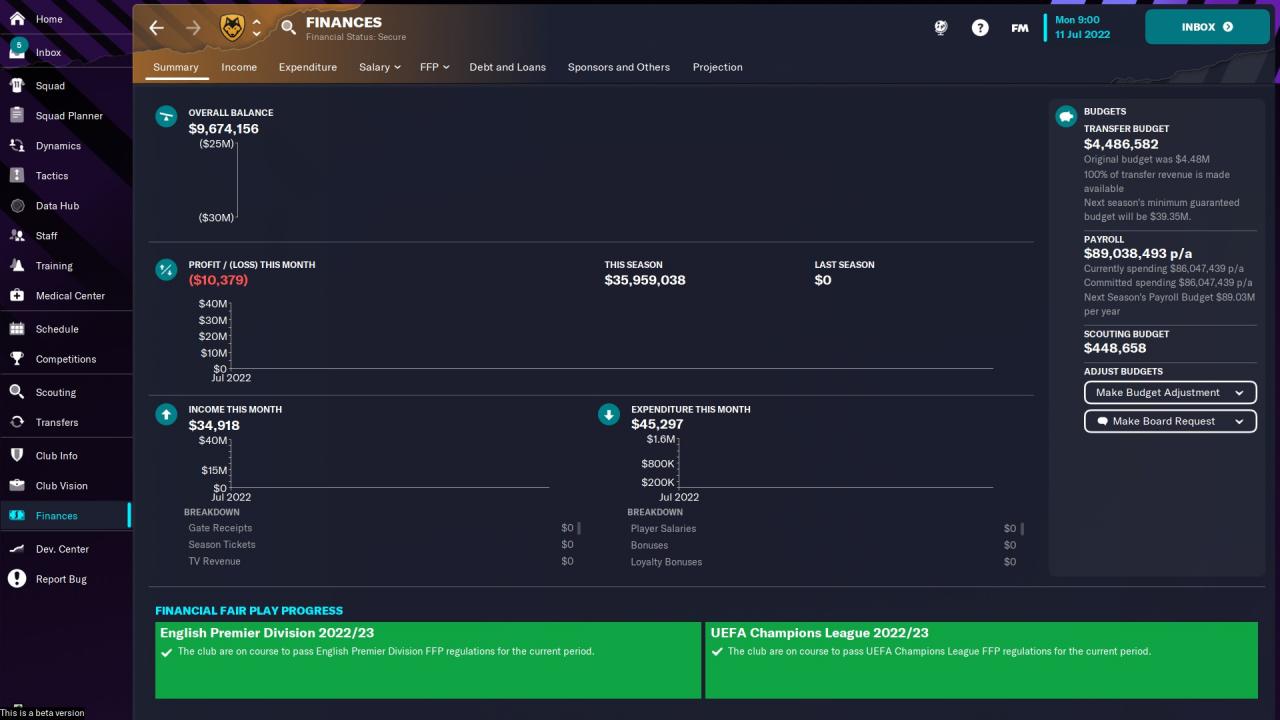
You can see that Wolves are doing alright, given they have about $10 million in the bank, a little over $4 million of transfer budget, and $3 million in annual payroll. This is further indicated by the “Financial Status: Secure” judgement and generally speaking they’ll be just fine at the end of the season as long as they stay within the payroll budget.
That being said, as a Premier League side, there isn’t much room to add quality either (assuming no player sales), and their best bet might be to bring in a bargain signing or a couple of loanees. Have a look at your club’s finances and just get an idea of what the money situation is: whether they have money to burn or must sell to stay afloat will determine how your first 1-3 seasons play out.
Squad Evaluation
Next, let’s check out what the Wolves squad looks like. Head over to the Squad tab to get a detailed list of all first team players at your club. I would highly recommend importing a “Squad View” (find those online easily) and filtering out players that are away on loan by selecting “Hide Players Not at Club” from the filter on the top right of the screen. Your view should be more or less similar to mine below (I have zoomed out the game for the purposes of this screenshot), and now let’s see what we’re working with.
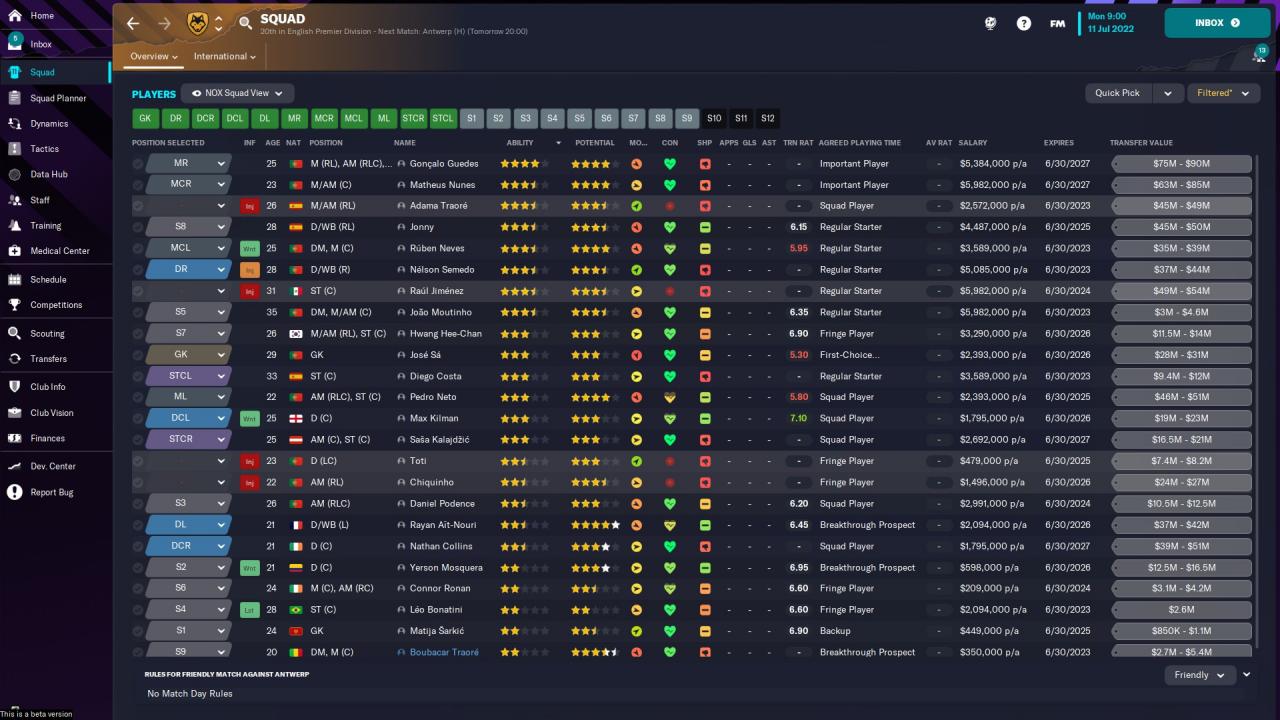
We can start off by identifying the key players at Wolves: if you’re new to the game, you can identify them by their higher Ability star ratings, but as you get more experienced you will learn to rely less on those and to judge players by their inherent attributes.
Still, to keep things simple here, I’ve sorted by star ratings, and we can immediately see players like Matheus Nunes and Goncalo Guedes spring to the top. They are followed by Wolves mainstays like Ruben Neves and Raul Jimenez, which is a group of players that I’d like to build around. Find a core of players you want to keep around, either because they are world stars or rock-solid veterans, these are the players we’ll be prioritizing in the next Tactics section.
Now let’s look at the positional strengths and weaknesses in the Wolves squad. You can now sort the Squad by Position to get a better view of where you have depth or are in need of reinforcements.
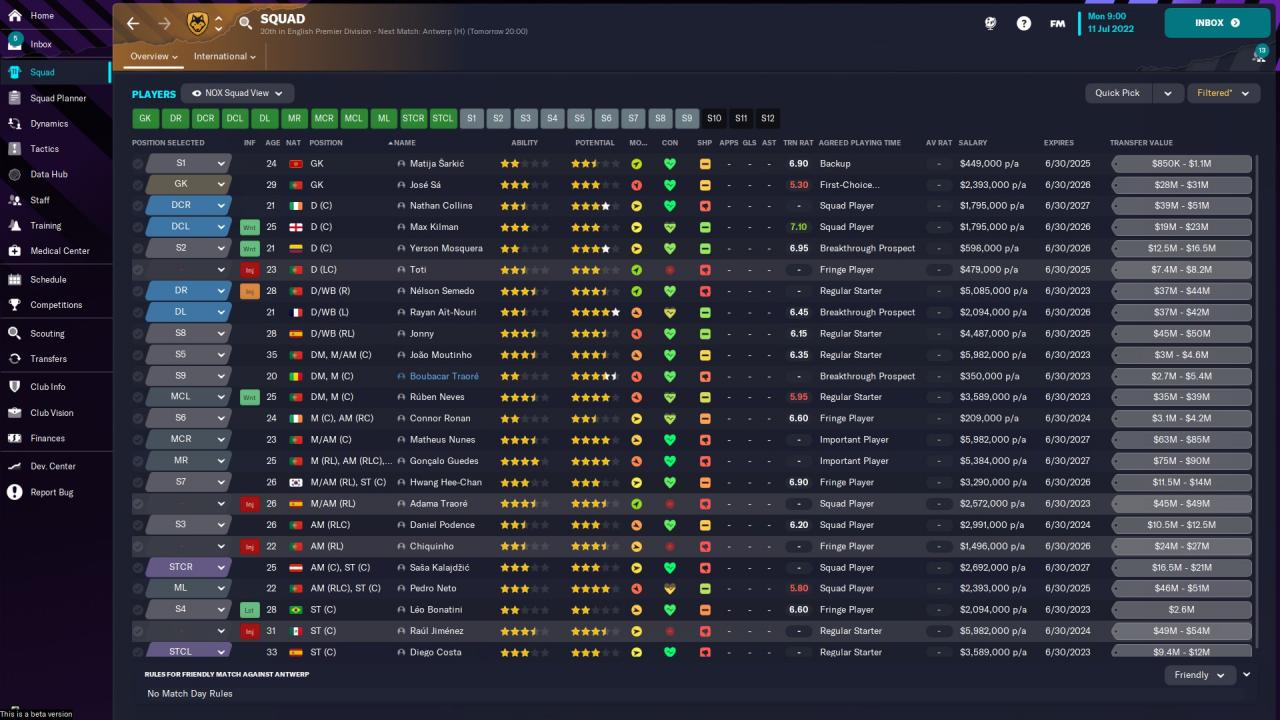
Starting from the top, I can already see that Wolves are a bit light on defenders, with just four inexperienced center-backs and only one natural right-back in Ait-Nouri. This is very important to keep in mind as we move later to Transfers: defenders are going to be priority signings for sure.
As for central midfielders, Wolves have 4-5 options to work with, including a strong Neves-Nunes pairing, so I’m likely to opt for a 2-man central midfield. Further up the pitch, Wolves have a rich selection of wide players, with names such as Guedes and Pedro Neto, so this is one part of the team that I’ll focus on heavily as I build my tactic. Finally, leading the line are players like Raul Jimenez and new signings Diego Costa and Kalajdzic, so I wouldn’t be against having a strike partnership.
Do this kind of a squad analysis not just to get an understanding of what tactic to play, but also to see which positions need more strengthening in your team. We’ll use this information in the next section as we build out a tactic.
Tactics
If you are a complete beginner, I’d suggest picking one of the pre-made tactics that the game recommends. You can later make tweaks to it based on your thoughts and observations as you understand the game a bit better. If you want to do your own thing instead, you can scroll down to “create your own style” and make a tactic from scratch. For this guide, I’ve quickly made a variation of the Wing Play 4-4-2 preset, which you can see below. I’ll be going over the basics here, but if you want in-depth information on tactic creation, there are hundreds of great guides available online.
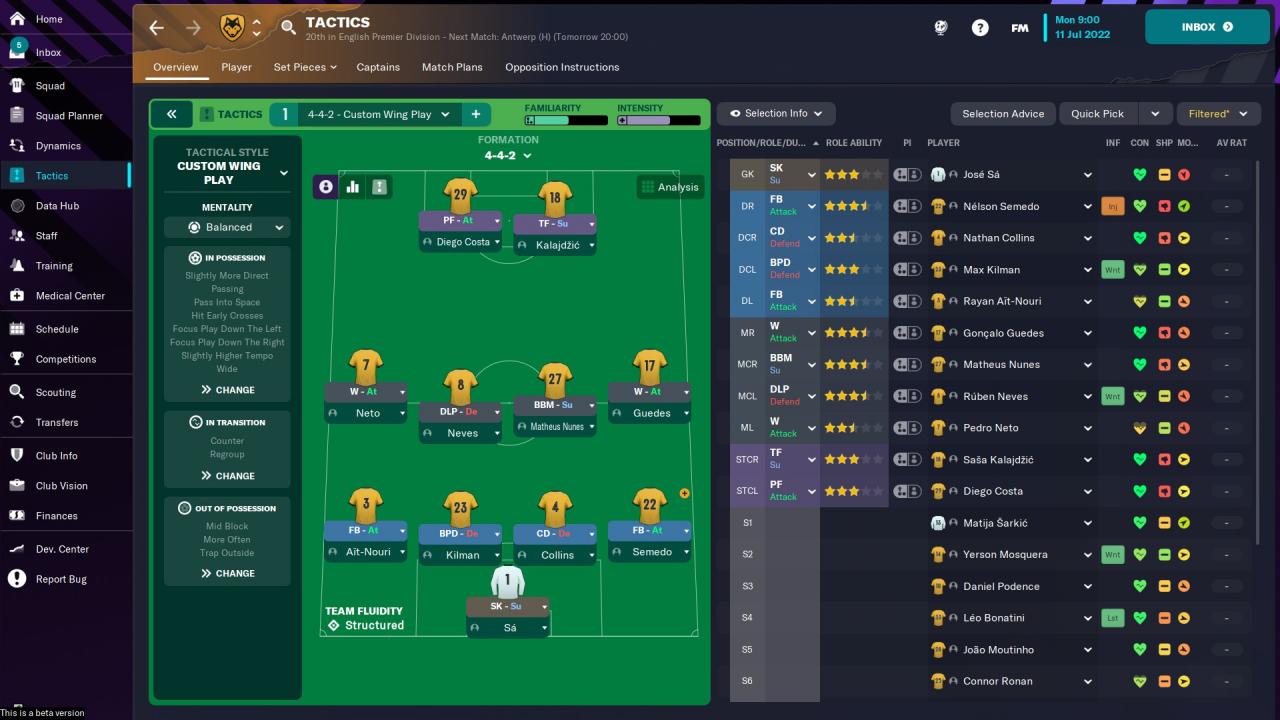
My rationale behind going for this shape is simple: I have a fairly thin backline, so I’d rather play with four defenders than five, because if I have even a few defensive injuries, I’ll be in trouble. I’ve opted for a two-man holding midfield in the form of Neves and Nunes, which is conservative but offers the latter the option of moving up to support the attack when needed, given his great Stamina and Work Rate. Going for wingers was a no-brainer, seeing the amount of depth and speed I have out wide, and up front I have physically adept players that can be Target Men or Pressing Forwards.
In terms of tactical instructions, I’ve kept it basic, with an emphasis on wide play in possession and early crosses. Without the ball, we’ll be looking to hold a mid block, slightly more frequent press triggers, and a press trap outside the box.
These are very much subject to change as you watch your team play over the season and notice what works and what doesn’t, and maybe what style suites specific players and what doesn’t. Be open to tweaking things but don’t make changes willy-nilly, give your team time to integrate tactics and gain familiarity (which you can see at the top of the tactics screen).
You can design your tactic in a similar way, making use of your strengths and star players, and minimizing the pressure on weak areas. If you are confused about what the roles (like playmakers or inverted wingers) mean, you can always hover over them and read the description of what they are.
Naturally, if you have a strong squad, then look to make a more aggressive tactic, but if you are expected to be at the bottom of the table, you may want to go for a defensive, counter attack focused one.
Alright, we’ve done the squad analysis and we’re ready to venture in to the transfer market, but first…
Development Center
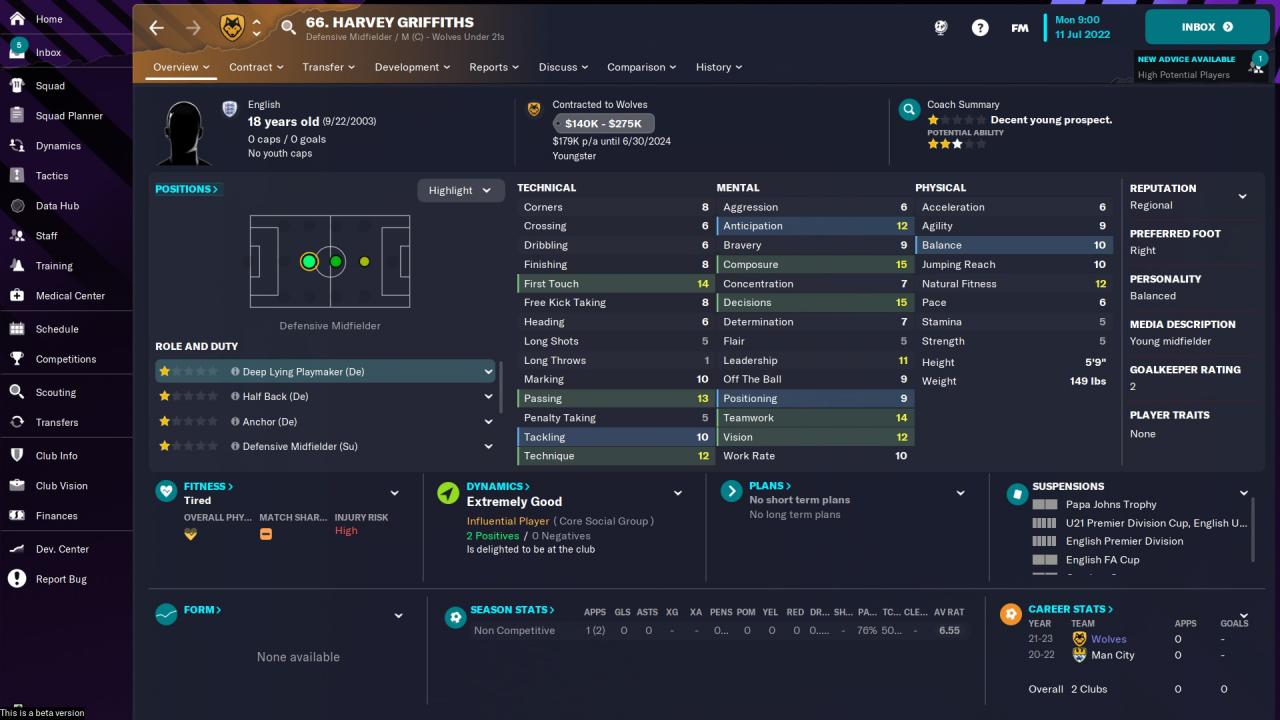
At Wolves, a player like Harvey Griffiths is one I’d like to keep an eye on and perhaps even give a few substitute appearances to. He fits the system I’m playing, has solid mental attributes, and enough potential to take a punt on.
You can have a look around to see if there are any such interesting prospects in the U21s or U18s. If not, you might even want to offload some players that look like they’ll never really develop and you’d rather have them off the books.
Either way, if you’ve looked around the club and not found the player you want, the next thing to do is jump into the depths of the transfer market.
Scouting and Transfers
From the Squad Evaluation section, remember I was looking for a couple of additions to my right-back and center-back positions. Keep in mind the positions you’re looking for, then head over to the Scouting tab.
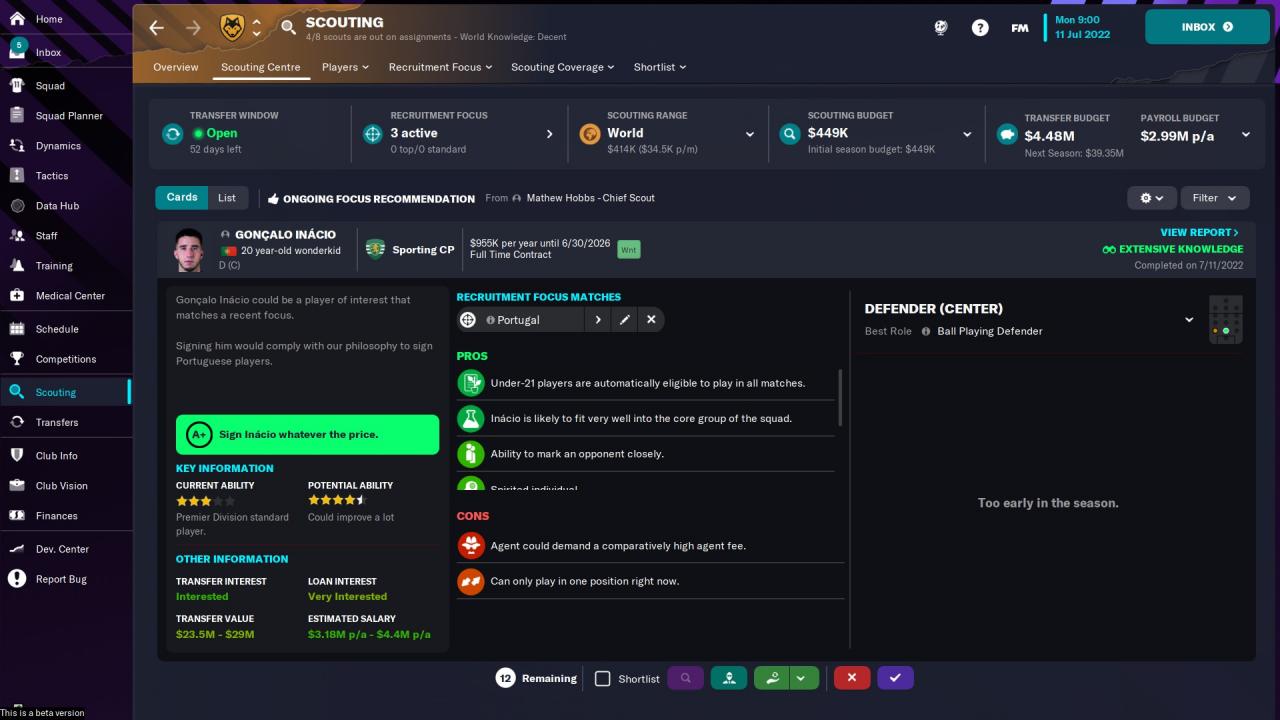
What I want to highlight first is the Scouting Center section, where your scouts will suggest players based on what assignments they’ve been on. You can adjust these assignments through the various scouting menus or leave them up to your Chief Scout. Again, this is something that has been revamped in FM23 and as such I am not an expert on, so I’d recommend making use of the various deep scouting guides and strategies online if you are curious.
For now you can see that my scouts have recommended a few players, the highest rated being Goncalo Inacio. Now, in theory, this would be a fantastic signing, given the fact that he’s a center-back, a wonderkid, and Portuguese, which matches Wolves’ signing philosophy. But, as you can see on the top right, I only have a $4.5 million transfer budget, which is not nearly enough to get his signature. Regardless, it’s a nice recommendation and I’d be wise to add him to my shortlist by right clicking his name.
Much more useful perhaps is the Players section, which will open a view like so. From here, you essentially become the scout. By searching the positions and attributes you want, you can get a complete list potential players that are willing to sign for you.
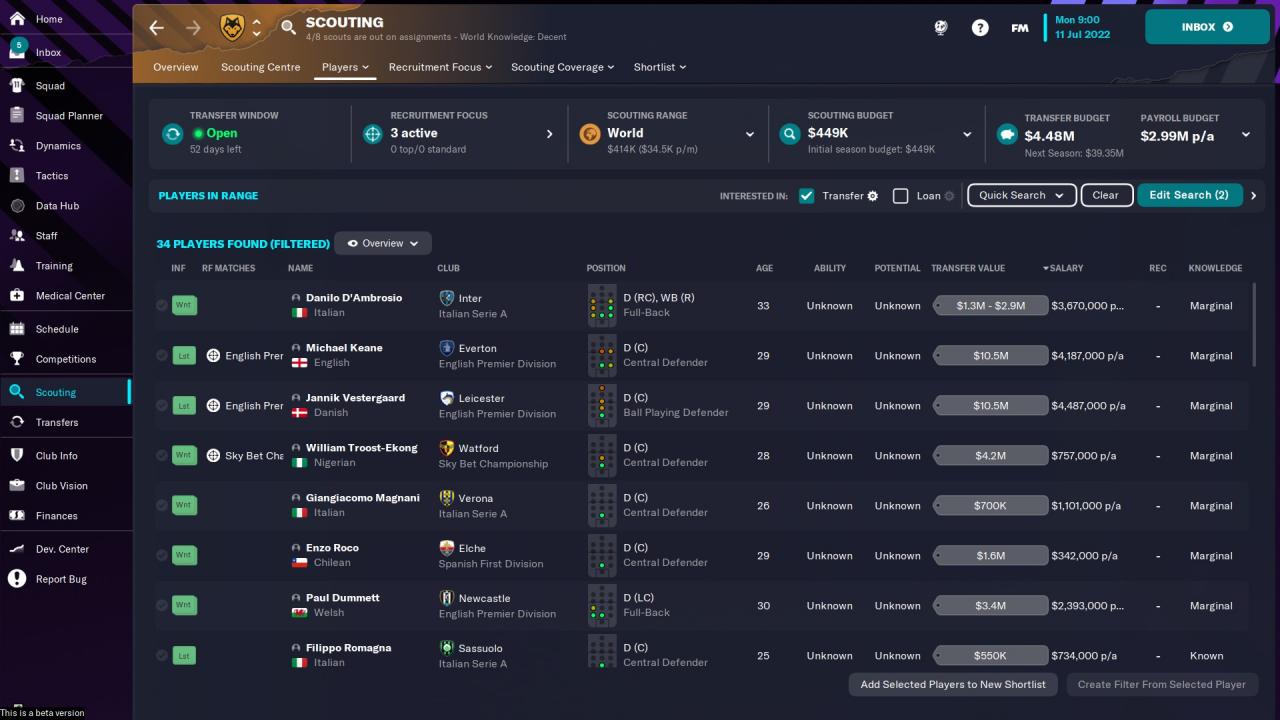
Now, I’ve filtered my search such that I only see center-backs that have been transfer listed by their clubs, so I can grab them for a much lower price than otherwise. The likes of Michael Keane catches my eye, given he is an experienced, established Premier League defender in his prime years. A signing like him would be a solid boost to my backline.
However, Everton have put a $10.5 million price tag on him, which I obviously cannot afford upfront. Instead, I could look to put in a load bid for him and only pay his wages and a future fee, given in my eyes he still has a number of quality years left in him.
If I was really strapped for cash, searching for loan listed center-backs could be the way to go, but keep in mind the quality here is lower and players tend to be at the start of their careers, which is not what I want at Wolves.
Using these two sections, you should be able to find the players you want for your squad. Make sure to scout them fully before signing and keep an eye out for injury prone or inconsistent players. Use the shortlist feature, as it will make it easier to choose between players or track targets over a period.
A common mistake among new players is going overboard with the number of signings, so go back to the squad section we referred to before as a guide to spend smartly. Keep in mind the club vision too! If you go around signing a bunch of 35-year-olds and your club vision is to sign players younger than 23, you might have some explaining to do to the board.
Staff

You can see how we compare to the rest of the league with the bar graphs at the bottom, and it’s very clear that Wolves are well below par in every aspect but Medical staff. You can also see how many members the coaching, medical, and scouting teams individually have.
Say I want to employ a General Manager, since I don’t have one at the club. I could either place an advert for that position, simply by clicking the add staff member icon and navigating to the place advert option. A few days later I’d get a list of staff members interested in joining as a General Manager.
However, a far better way to employ staff members is through the staff search tab. Almost identical to the player search section, this allows you to filter staff by their jobs and attributes. For instance, if I wanted a technical director with 18 Negotiating, I could add those filters and get all the best staff in the business.
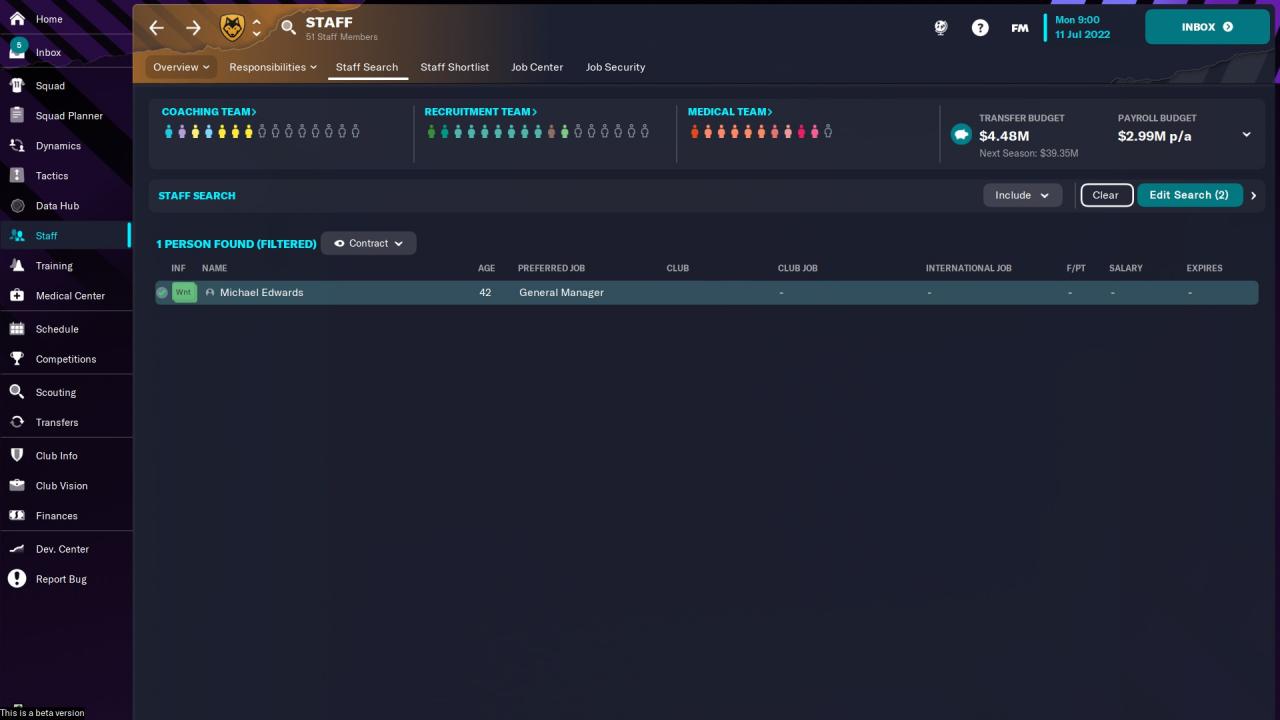
Then, if you hover over the overview section, you can see your coaching, medical, and scouting teams. Go through the staff here, and if a staff member is clearly inferior, I would not hesitate to mutually terminate their contract to free up space for other staff.
If you are interested, you can even handpick coaches by their personalities and preferred formations and playing styles. This does have an influence on how teams train, so it is a clever idea to keep an eye on that. Again, watch out for the finances: do not break the bank just to get a slightly better staff member.
Training
In FM, there are two types of training: general and individual. These are self-explanatory, general training refers to the training the team does together, and individual training is specific training assigned to an individual.
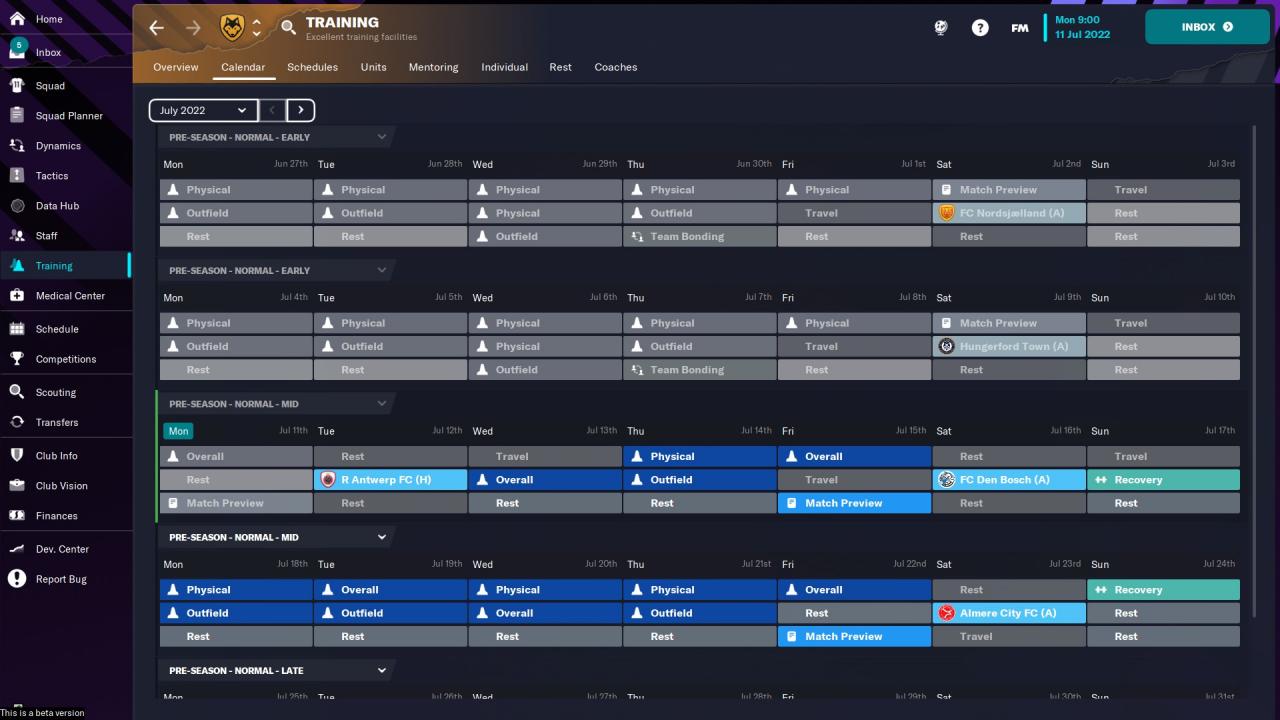
You can see the general training of a team through the calendar section and personally adjust the training sessions from there. For now, Wolves are going through Normal Pre-Season training sessions, but you can chop and change those the way you’d like. You could even leave them to the assistant coach, who will schedule them based on what he thinks the team should work on.
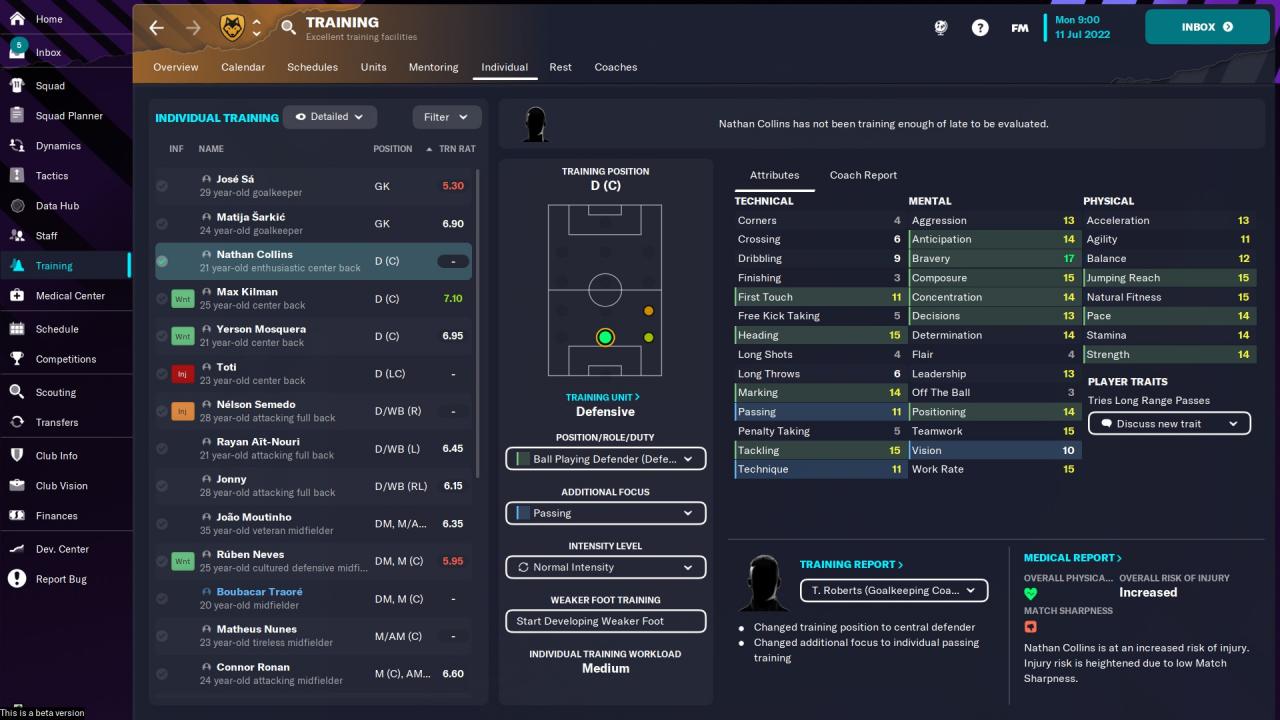
Individual training is something I’d highly recommend doing yourself. You can access the individual section, from where you can see each player and what position for which they are training. From there, you can set what each player individually will be training for as well as any additional focus.
In this case, I want Nathan Collins to be training more as a Ball Playing Defender with an additional focus on passing to improve his technical aspects when on the ball. I find this to be great to mold younger players to fit your system or change their role, while it naturally has less of an impact on older players.
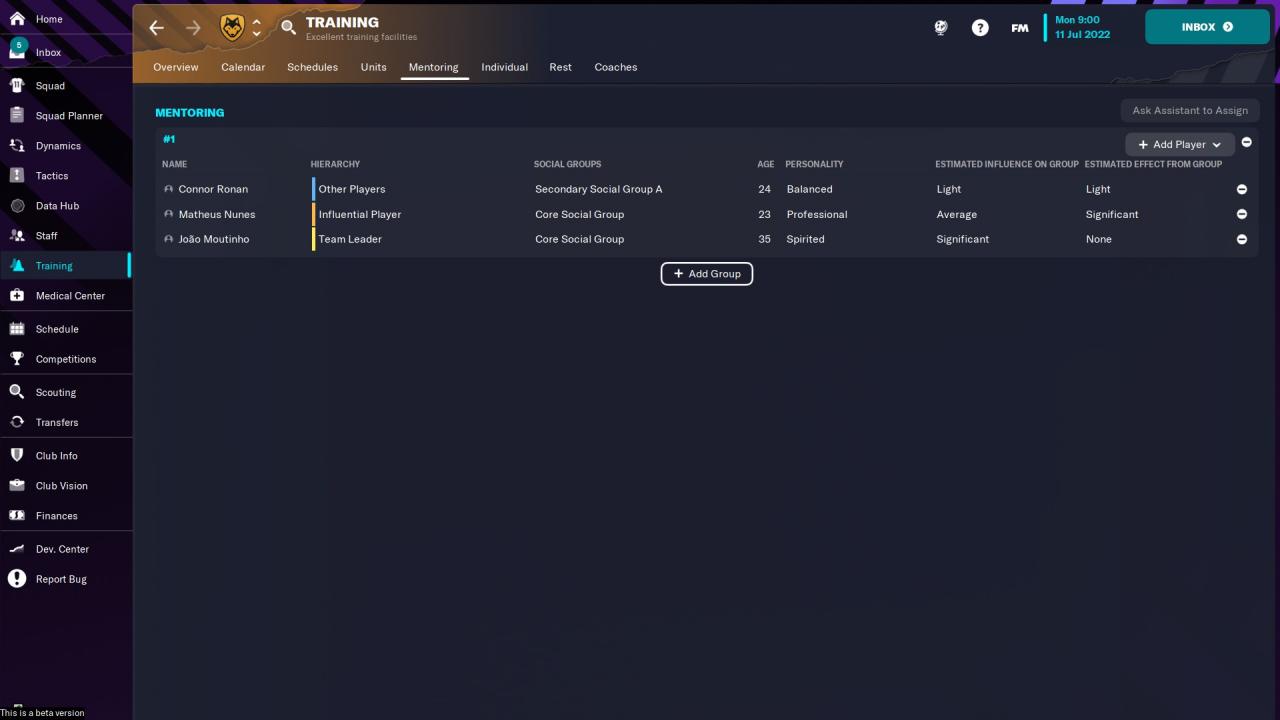
Next, we can go to another aspect of training: mentoring. This replaced the tutoring system a number of years ago; now, you make mentoring groups, wherein players learn from each other.
In this example, experienced players with strong mental attributes and personalities will influence younger ones like Matheus Nunes and Connor Ronan. This can be a great way to mold the mentalities of young players, and perhaps even transfer over some player traits.
Facilities
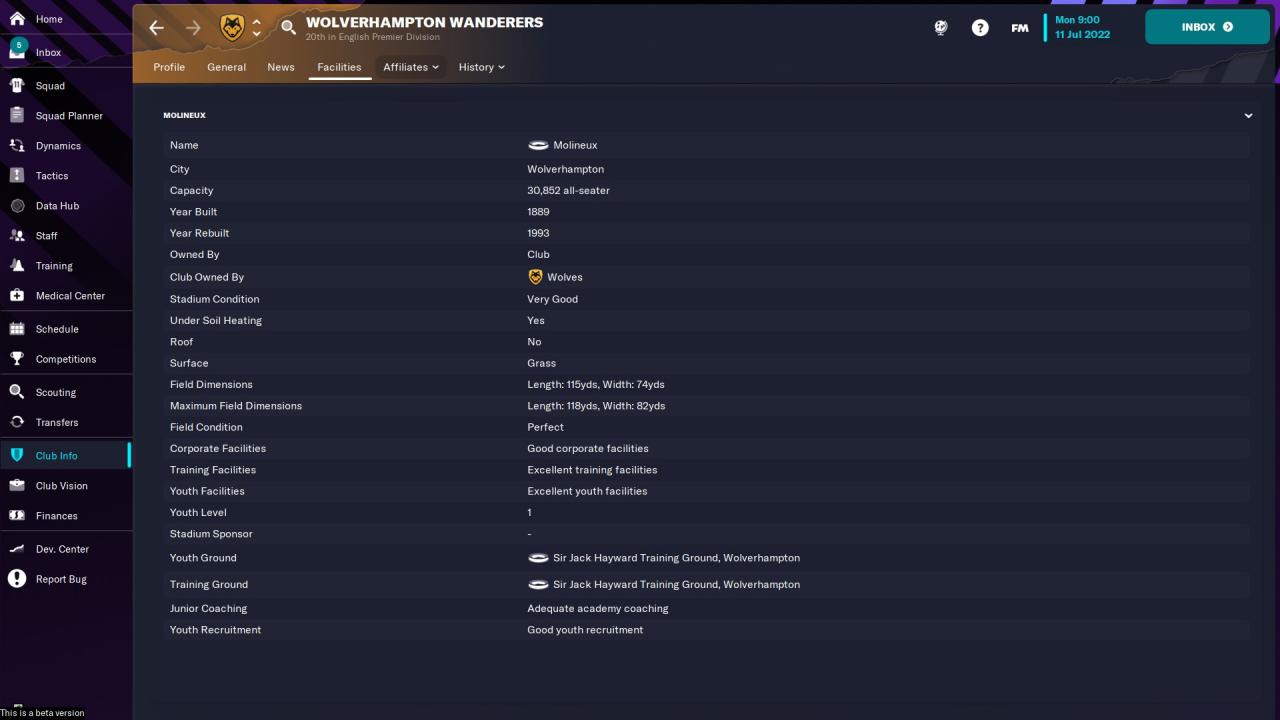
In terms of Training and Youth Facilities, the club is in excellent shape, which is great news. Things are a little lacking in the Youth Recruitment side of things, but nothing that can’t wait until the financial situation improves.
You can request your board to improve facilities through the Club Vision tab, and then by clicking on the Make Board Request dropdown. It is a good idea to try and improve them whenever you have the budget to do so. In long term saves especially, better facilities go a long way.
What’s Next?
You could also go ahead and explore other tabs that I did not talk about in this guide. The Dynamics and Medical Center offer interesting information on the state of the team, while the Club Vision is all about what the board and fans expect from you. If you’re a data buff and want to dive into the numbers surrounding your team, the Data Hub is for you.
